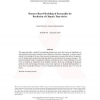Free Online Productivity Tools
i2Speak
i2Symbol
i2OCR
iTex2Img
iWeb2Print
iWeb2Shot
i2Type
iPdf2Split
iPdf2Merge
i2Bopomofo
i2Arabic
i2Style
i2Image
i2PDF
iLatex2Rtf
Sci2ools
MLDM
2009
Springer
2009
Springer
Memory-Based Modeling of Seasonality for Prediction of Climatic Time Series
The paper describes a method for predicting climate time series that consist of significant annual and diurnal seasonal components and a short-term stockastic component. A memory-based method for modeling of the non-linear seasonal components is proposed that allows the application of simpler linear models for predicting short-term deviations from seasonal averages. The proposed method results in significant reduction of prediction error when predicting error time series of ambient air temperature from multiple locations. Moreover, combining the statistical predictor with meteorological forecasts using linear regression or Kalman filtering further reduces error to typically between 1 ◦ C over a prediction horizon of one hour and 2.5 ◦ C over 24 hours. Machine Learning Journal This work may not be copied or reproduced in whole or in part for any commercial purpose. Permission to copy in whole or in part without payment of fee is granted for nonprofit educational and research pu...
Electric Research Laboratories | Machine Learning | Mitsubishi Electric Research | MLDM 2009 | Seasonal Components |
| Added | 27 May 2010 |
| Updated | 27 May 2010 |
| Type | Conference |
| Year | 2009 |
| Where | MLDM |
| Authors | Daniel Nikovski, Ganesan Ramachandran |
Comments (0)

